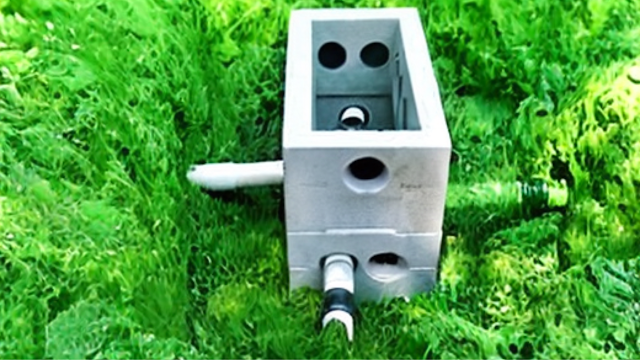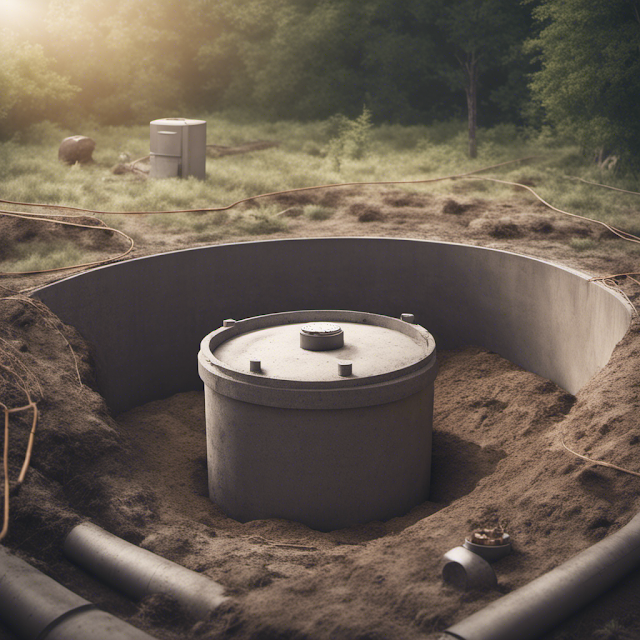How Often Are Septic Tanks Emptied, and Where Does All the Yucky Stuff Go?
.png) |
| How Often Are Septic Tanks Emptied is more than this Septic Tank has been |
Pondering "How Often Are Septic Tanks Emptied?" 💭 Uncover the answer (typically every 3-5 years) and learn why diligent care is vital for a clean, stress-free home. Stay with us for expert tips that make septic tank maintenance a walk in the park! 🚽✨
How Often Are Septic Tanks Emptied?
In today's contemporary and new built homes, we often take our drainage systems for granted. As long as the toilet isn't overflowing or the bathtub throwing up unpleasant smelly pieces of our own well you know. We don't usually give much thought to plumbers or septic tankers. With a simple flush, waste disappears from our sight and our thoughts. However, this article looks deep into into the world of septic systems, taking you to your backyard's lushest patch of grass.
.png) |
| Jeane and Michael Sadler, a husband and wife team who have been working with septic tanks for over 40 years |
Our Professional Perspective on How often are Septic Tanks Emptied
Dive into the World of Septic Services with Our 40 Years of Expertise 🚽💡
As seasoned veterans with more than 40 years of hands-on experience running a Septic Tank Company, we've tackled a plethora of situations and challenges in the industry. Our passion for sharing the priceless knowledge we've accumulated over the years led us to create this blog, designed to assist both current septic tank owners and those considering a new system installation. Embark on this journey with us as we delve into the fascinating universe of septic tank services, using our expertise to ensure your "How Often Are Septic Tanks Emptied" experience is as smooth and hassle-free as possible. Along the way, we'll highlight the importance of heeding septic tank warnings to keep your system in tip-top condition.
So how many of us have Septic Tanks.
Based on data from the U.S. Census Bureau, around 2010, approximately 26 million residences in the United States relied on septic systems for waste management. This accounts for nearly 20% of all households in the nation. The prevalence of septic systems differs significantly across states, with the highest usage observed in Vermont (55%), Maine (50%), New Hampshire (45%), and Rhode Island (40%). Conversely, the states with the lowest adoption rates include California (10%), Hawaii (11%), and New York (12%).
In people numbers now over 60 million Americans rely on septic systems to handle their household waste, and about one-third of new developments incorporate these systems. By nature, septic systems are relatively straightforward. All drains in a home come together into a single pipe that connects to the buried septic tank outside. As water from your toilet, shower, basins, and laundry machine departs your residence, it merges together. Once it reaches the septic tank, the waste starts to separate.
The heaviest particulate matter in the waste, known as sludge, settles at the bottom. Meanwhile, fats, oils, and proteins form the floating scum layer at the top. Sandwiched between these layers is the relatively clear liquid layer called effluent or gray water. Collectively, these components make up what we call septage.
Septic setups are engineered to ensure that solely the outflow gets released from the container into the drainage area, commonly referred to as the leach field.. This consists of a set of pipes with holes drilled into them, which release the effluent below ground but above the water table. The effluent is degraded enough to be effectively filtered by good soil. The remaining organic material in the effluent acts as a fertilizer, which is why the drain field usually has the healthiest section of the yard above it.
Although their structure is straightforward, it is essential for homeowners to keep an eye on their septic systems to avert potential issues. Generally, once a problem becomes noticeable, it's too late for an easy solution. Addressing major septic issues can often require thousands of dollars in parts and labor. Fortunately, regular maintenance can help avoid such problems. Keep reading to find out how often you should pump out your septic tank.
Disposing of Septage: From Revolting to Resourceful
In areas with a high number of homes using septic tanks, you'll likely find several local businesses that specialize in removing the scum and sludge accumulating in the tank over time. This is a crucial service; if too much sludge builds up, it can lead to overflow, which is bad news for everyone.
In most cases, commercial septic pumping includes employing a pump truck to extract the accumulated solids, liquid waste, and floating matter from the tank, leaving it empty and set for the next filling cycle. Once the waste is removed, there are limited options for its disposal. Before federal laws restricted septic sludge dumping, waste companies could simply bury it in dumpsites. As these sites were recognized as health hazards, they were outlawed. Many of these sites remain, although numerous are undergoing remediation (cleanup).
Nowadays, federal and state laws dictate the final destination of your septic tank's contents. In some cases, the septic waste is transported to waste treatment plants, added to the mix piped in from municipal sewer systems, or delivered to independent, for-profit companies specializing in septage treatment. Septage may also be disposed of in approved landfills. However, the guidelines governing septage dumping are stringent, and suitable sites can be scarce.
Because of the challenges posed by disposing of your septic tank's contents, septage is often repurposed in another way: as a fertilizer for food crops. Unless there's a "USDA Organic" label on it, it's possible the food on your table was grown using the sludge that was once in your septic tank.
This use of septage can be controversial. Proponents, including many commercial farmers, argue it's a win-win situation since municipalities don't have to worry about waste disposal, and farmers receive inexpensive fertilizer for their crops.
When used appropriately on agricultural land featuring healthy soil and a shallow water table, the soil should function as a filtering medium, akin to a drainage area in a residential setting. a septic tank. However, the use of biosolids in agriculture is a contentious subject and continues to be scrutinized as a potential health and environmental threat. While some view it as an effective way to recycle waste, others, including scientists and health professionals, believe that using biosolids in agriculture poses risks to both farmland and public health.
There's another, more innovative way to use septage — generating electricity to power homes. It has long been known that methane, a byproduct of sewage breakdown, could be harnessed to generate electricity. While methane is a simple fuel, it can also be broken down and used to produce electricity using fuel cells located on-site at treatment plants. The electricity generated in this process doesn't combust, resulting in little to no pollution.
Septic Tank Cleaning FAQs
How often should a septic tank be pumped?
Septic tanks should be pumped every three to five years and inspected by a professional once every three years.
Can I pump my septic tank myself?
Attempting to pump your septic tank yourself can result in hefty fines. In most neighborhoods and localities, licensed companies are responsible for this task.
Do septic tank additives help?
No, research has shown that chemical and biological additives can actually be harmful to septic systems.
How do I know if my septic tank needs cleaning?
If your drains are blocked and there is an unpleasant odor, it's likely that your septic tank needs cleaning. Even if these signs aren't present, you should consider having your septic tank cleaned if it's been three to five years since the last pumping.
How expensive is it to clean a septic tank?
On average, cleaning a septic tank costs around $375. Pumping out the tank can cost $250 for a 3,000-liter tank and approximately $1,000 for a 5,000-liter tank.
Exploring Different Septic Systems
Various types of septic systems are available to homeowners, each with its own advantages and disadvantages. These systems can be broadly categorized into conventional systems, alternative systems, and aerobic treatment units.
Conventional Systems
Conventional septic systems are the most common and include gravity systems and pressure distribution systems. Gravity systems rely on the natural slope of the land to move effluent from the septic tank to the drain field. Pressure distribution systems use a pump to evenly distribute effluent across the drain field, which can be more efficient and better suited for properties with uneven terrain or shallow soil.
Alternative Systems
Alternative septic systems are designed for properties with specific site limitations, such as high water tables, poor soil quality, or limited space. Examples of alternative systems include mound systems, sand filter systems, and evapotranspiration systems. These systems typically require more advanced technology and maintenance but can be effective solutions for challenging properties.
Aerobic Treatment Units
Aerobic treatment units (ATUs) use oxygen to break down waste more efficiently and rapidly than conventional septic systems. These systems can be especially useful for properties with limited space or poor soil conditions. However, ATUs often require more frequent maintenance and higher energy consumption.
Detecting a Failing Septic System
Being aware of the common signs of a failing septic system can help you address issues before they become major problems. Some key indicators include:
Slow draining fixtures, such as sinks, bathtubs, and toilets
Sewage odors near the septic tank or drain field
Wet spots or lush vegetation growth near the drain field, indicating possible leakage
If you notice any of these signs, contact a septic system professional for an inspection and necessary repairs.
Tips for Preventative Maintenance
Proper maintenance of your septic system can help prolong its lifespan and prevent costly repairs. Here are some helpful tips:
Be mindful of what goes down the drain: Avoid disposing of harsh chemicals or non-biodegradable items in sinks and toilets, as they can harm the septic system's functionality.
Conserve water: Excessive water use can strain your septic system. Try to space out water-intensive activities, such as laundry, and fix any leaks promptly.
Maintain the drain field: Keep the drain field clear of trees, shrubs, and heavy vehicles, as their roots and weight can damage the system.
Schedule regular inspections and pumping: As recommended, have a professional inspect your septic system every three years and pump it every three to five years.
By following these tips and staying vigilant about potential issues, you can keep your septic system running smoothly and avoid costly problems down the line.
Understanding the Importance of Septic Tank Size
The size of your septic tank plays a crucial role in determining how often it should be emptied. Larger tanks can hold more waste, allowing for longer intervals between pumping. When planning a new septic system or replacing an existing one, it's essential to choose the appropriate tank size for your household. Factors to consider include the number of occupants in your home, the average daily water usage, and any future changes to your household size or water consumption.
Environmental Impacts of Septic Systems
It's crucial to understand the potential environmental impacts of septic systems to ensure responsible waste management. When septic systems are well-maintained and functioning properly, they can effectively treat wastewater and protect the surrounding environment. However, if a system is not maintained, it can lead to groundwater contamination, surface water pollution, and soil degradation.
To minimize the environmental impact of your septic system:
Follow recommended maintenance schedules and guidelines.
Use environmentally friendly household products that won't harm the system.
Properly dispose of hazardous waste, such as motor oil or paint, at designated facilities rather than pouring them down the drain.
Emergency Situations and Septic System Backup
Septic system backups can create hazardous and unpleasant situations for homeowners. Knowing what to do in case of an emergency can help minimize damage and restore the system's functionality as quickly as possible.
If you suspect a septic system backup:
Stop using water immediately to prevent further backup and damage.
Inspect the septic tank access port or manhole to determine if the tank is full or if there is an obstruction in the system.
Contact a professional septic service provider to assess the situation and perform any necessary repairs or maintenance.
In some cases, backups can result from issues beyond the septic system, such as blocked sewer lines or excessive rainfall. Regardless of the cause, addressing the problem promptly and professionally is essential to protect your home and the environment.
The Future of Septic Systems: Innovations and Trends
As technology and environmental concerns continue to evolve, the septic system industry is adapting with new innovations and trends. Some of the latest advancements include:
Smart septic systems: These systems utilize sensors and monitoring devices to provide real-time data on the system's performance, allowing homeowners and professionals to address issues more proactively and efficiently.
Green septic systems: These eco-friendly designs incorporate elements such as constructed wetlands or natural filtration systems to further minimize environmental impacts.
Decentralized wastewater treatment: In some communities, small-scale, neighborhood-based treatment systems are being explored as an alternative to traditional, centralized sewage treatment plants.
By staying informed about the latest advancements and best practices in septic system management, homeowners can contribute to a more sustainable future while ensuring the efficient and reliable operation of their own systems.
Research and Fact Checked:
https://www3.epa.gov/npdes/pubs/septage.pdf
https://www.usda.gov/media/blog/2016/07/22/understanding-usda-organic-label
.png)



.png)






Comments
Post a Comment